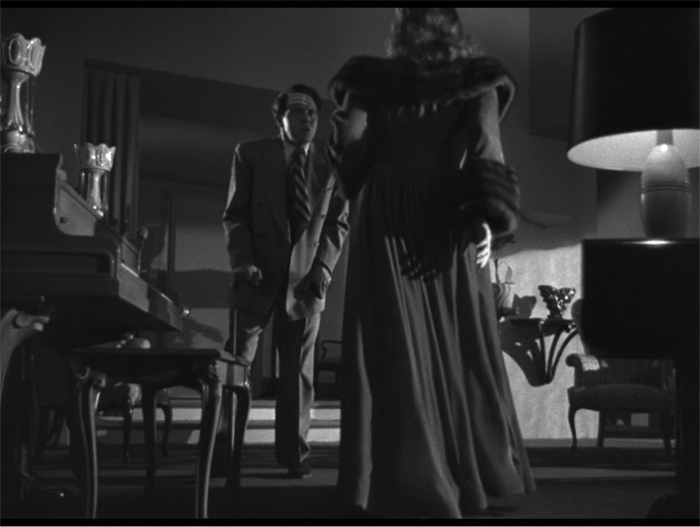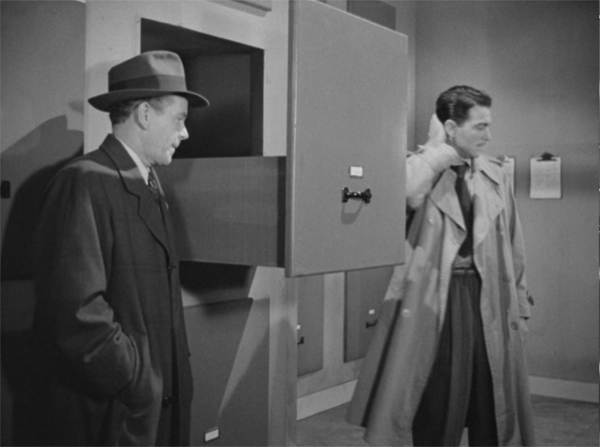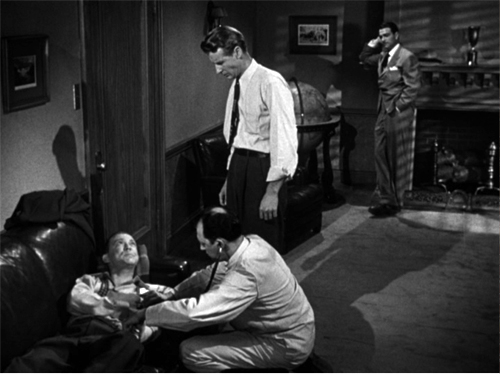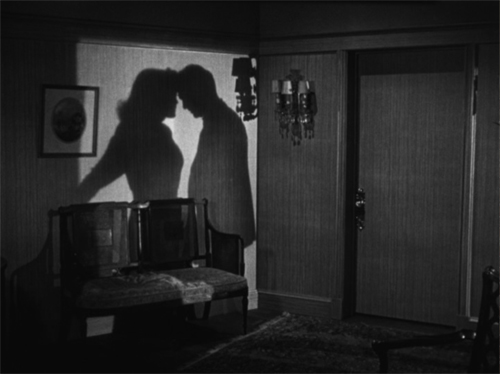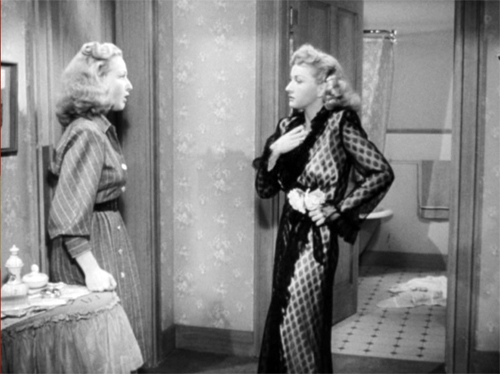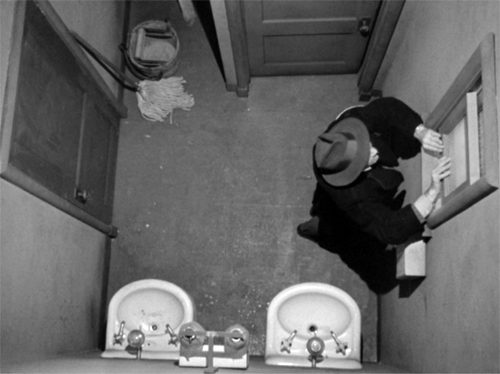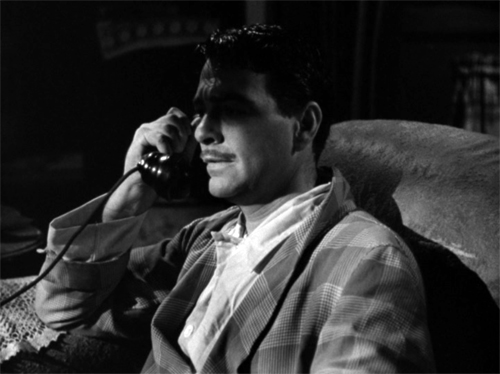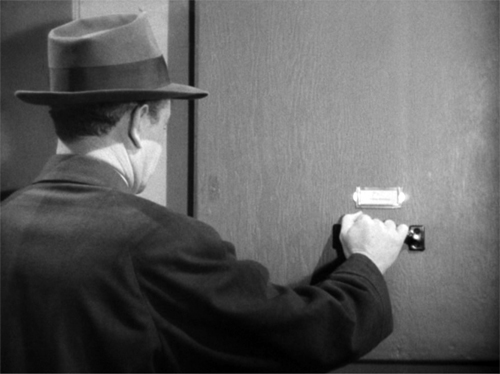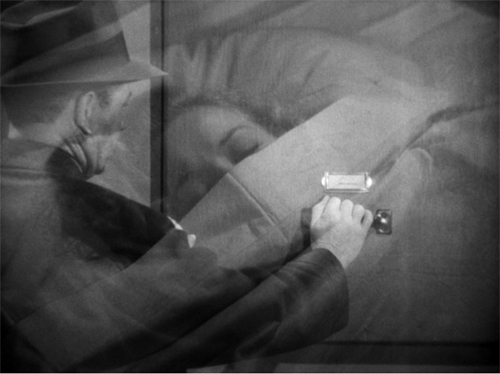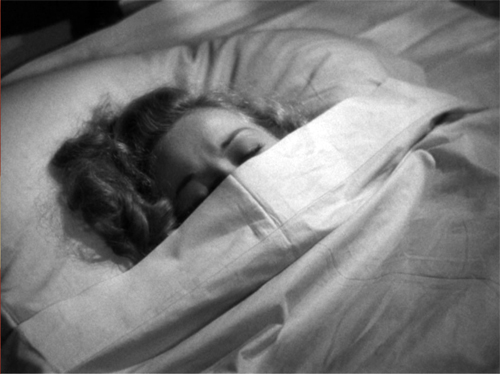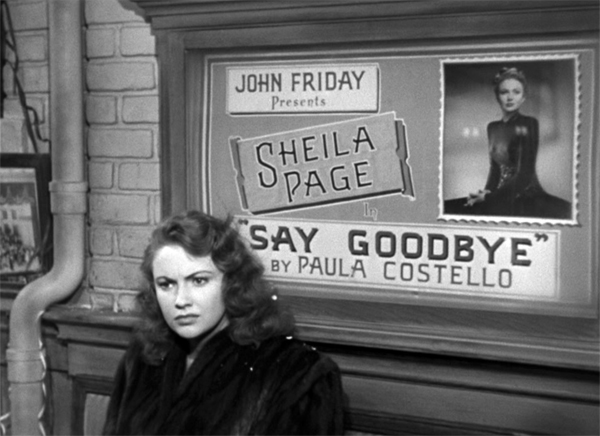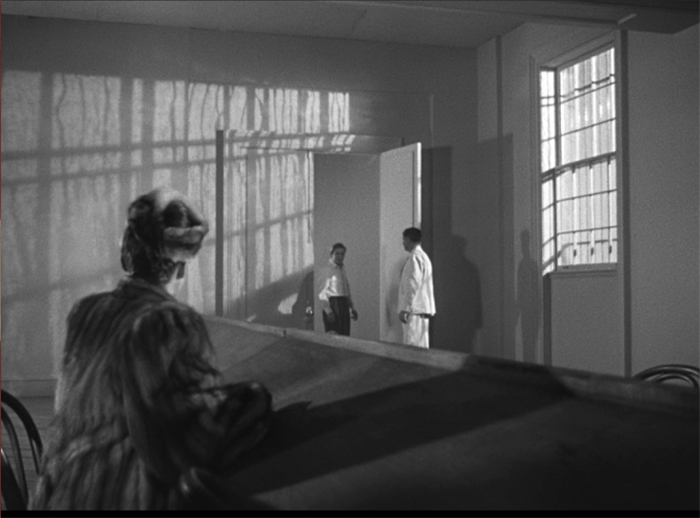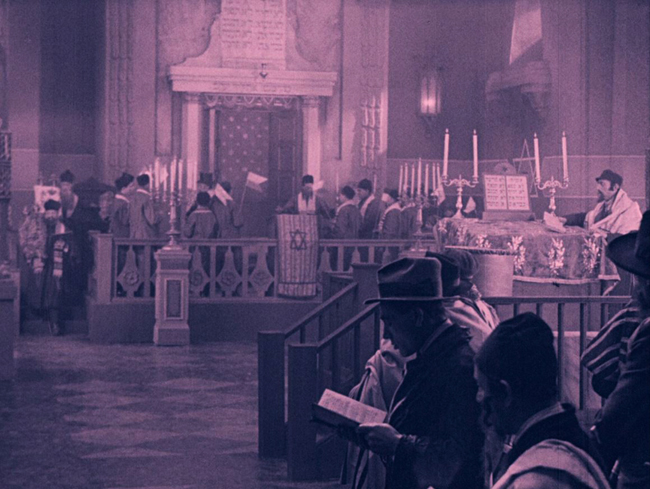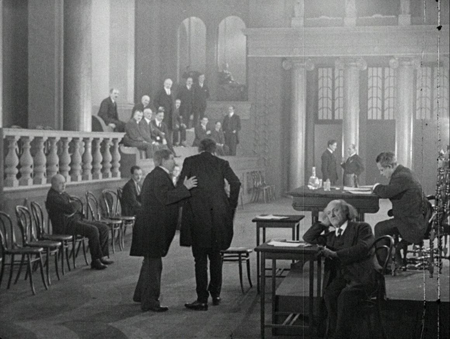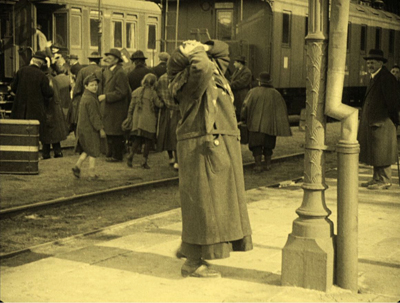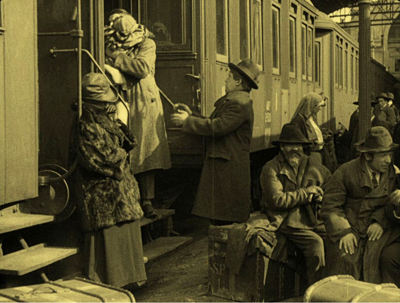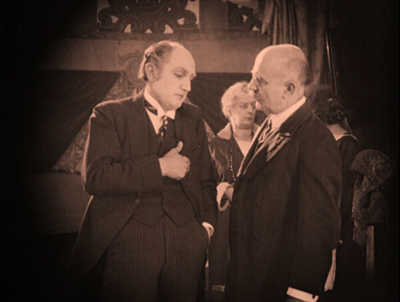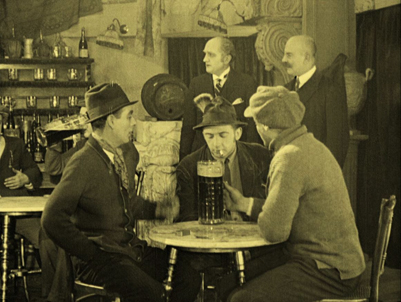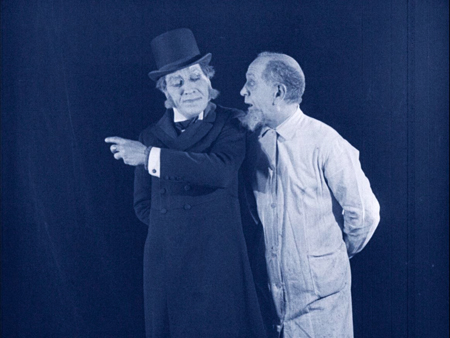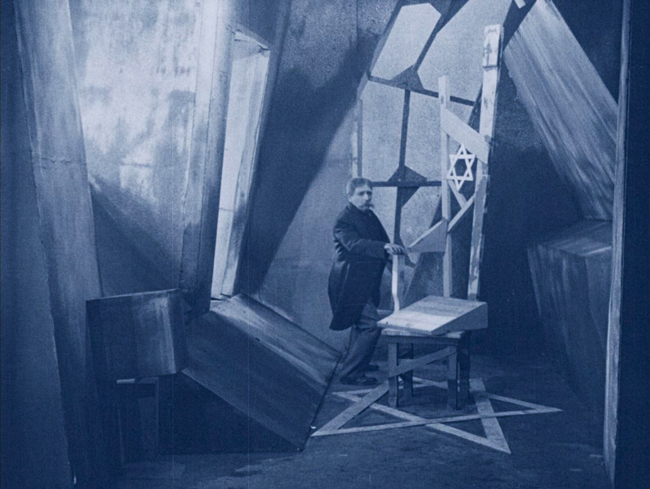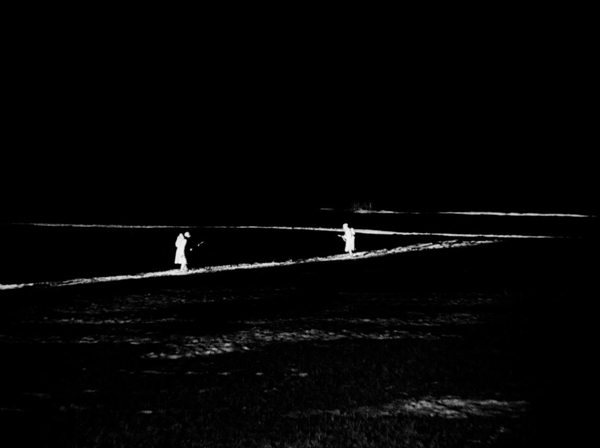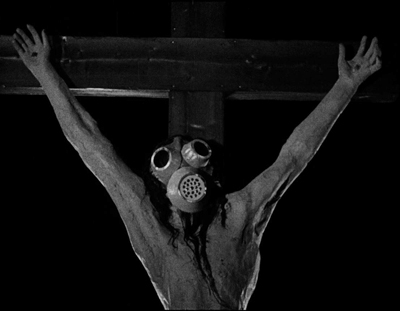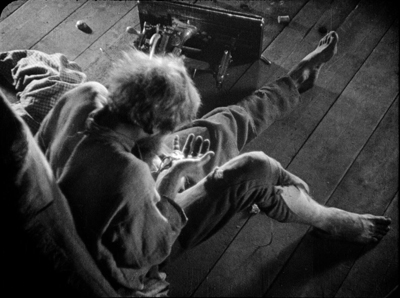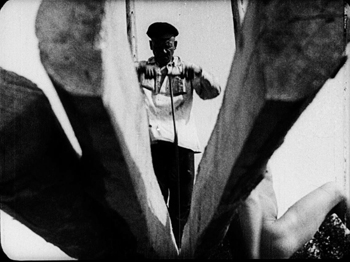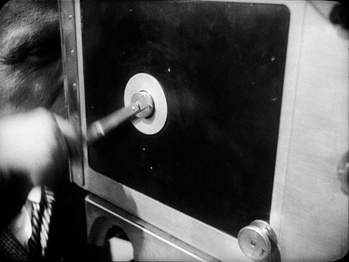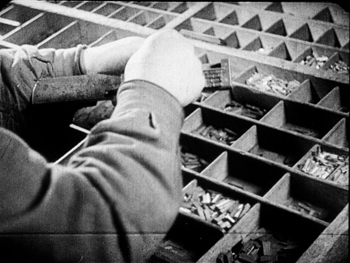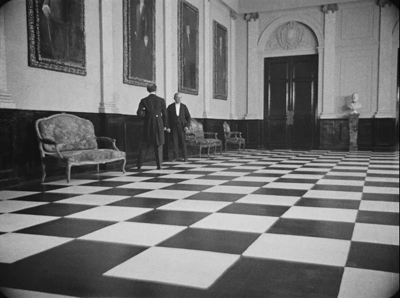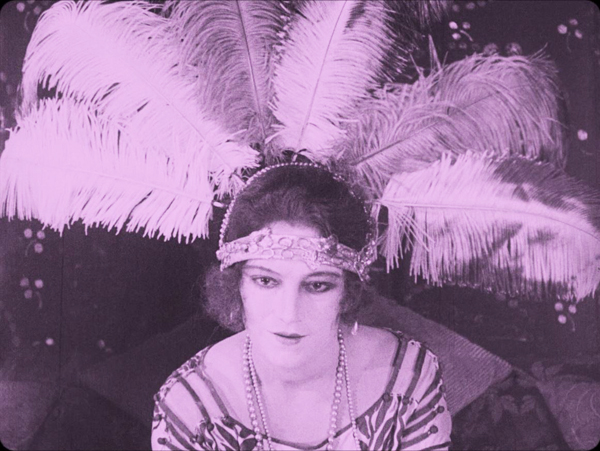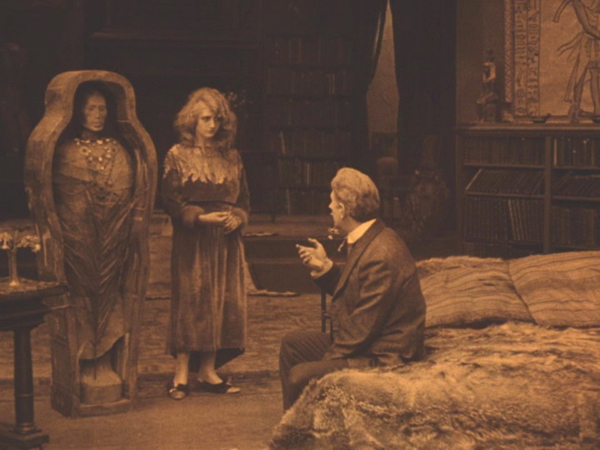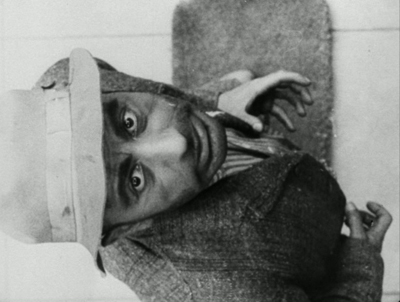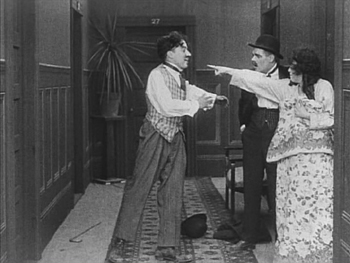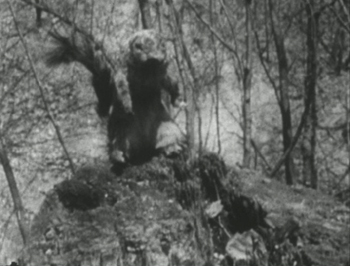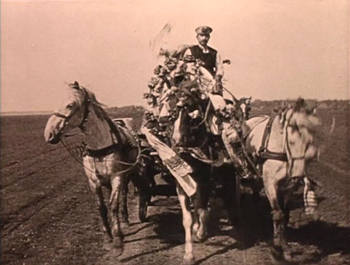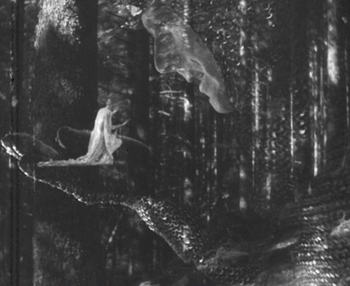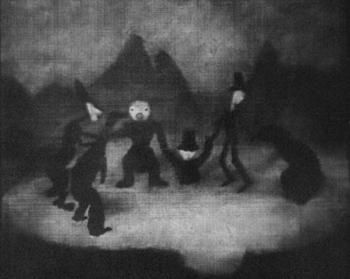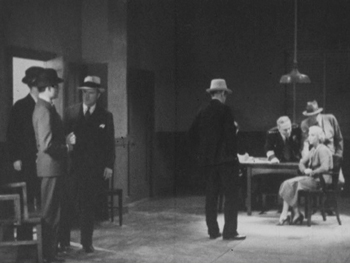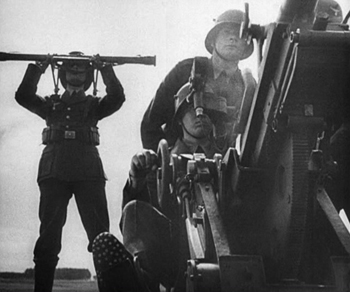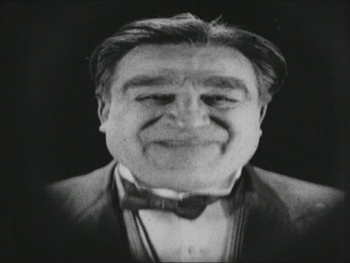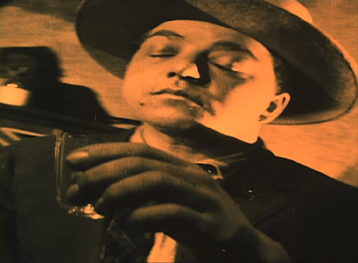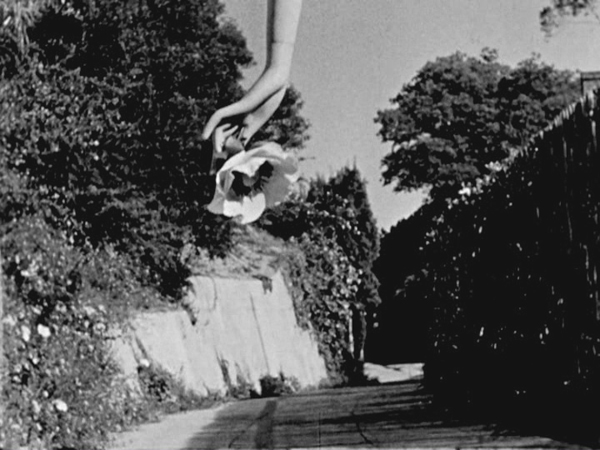Archive for the 'DVDs' Category
Noir x 3
Repeat Performance (1947).
DB here:
For several years, the Film Noir Foundation has initiated recovery and restoration of a great many neglected films, mostly from Hollywood. Thanks to Flicker Alley, several of those have made their way to DVD and Blu-Ray. (Earlier blog entries have considered the editions of Trapped and The Man Who Cheated Himself.) Now come two more discs, with beautifully restored copies and informative supplements.
The Monogram Touch
The Guilty (1947).
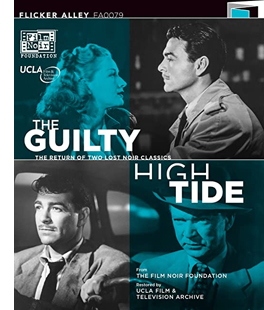 A generous double-feature disc displays what smooth B-filmmaking can look like. High Tide (1947) tells of Tim Slade, a rogue reporter brought back to work under his tough editor, Hugh Fresney. Fresney wants Tim’s help in taking on the city’s crime syndicate. Tim’s position is complicated by his past affair with the wife of the paper’s publisher, who’s hesitant to challenge the mob. A secret file on the gang becomes the target of Tim’s investigation, leading to an amiable former reporter Pop Garrow. The reversals pile up and lead to a surprise revelation at the climax.
A generous double-feature disc displays what smooth B-filmmaking can look like. High Tide (1947) tells of Tim Slade, a rogue reporter brought back to work under his tough editor, Hugh Fresney. Fresney wants Tim’s help in taking on the city’s crime syndicate. Tim’s position is complicated by his past affair with the wife of the paper’s publisher, who’s hesitant to challenge the mob. A secret file on the gang becomes the target of Tim’s investigation, leading to an amiable former reporter Pop Garrow. The reversals pile up and lead to a surprise revelation at the climax.
A noteworthy feature is a significant gap in a key scene. I can’t say more here, but the audio commentary by Alan K. Rode explains that although the complete scene is in the script, every print he has seen contains this omission. He speculates it might have been cut to shorten running time. I also wondered whether, since the print is a British one, the portion might have been snipped for censorship reasons. Interestingly, the AFI plot synopsis includes the scene. But 1947 sources give the original running time as 70 minutes, the same as the version we have, so the mystery remains.
Like other 1940s films, High Tide has a crisis structure. It starts with Tim and Fresney trapped in a car about to be swamped by the incoming tide. We then flash back to the events leading up to that. Director John Reinhardt and cinematographer Henry Sharp give us crisp, no-nonsense scenes making flexible use of depth staging (often to set Tim off as observer) and offering the occasional eye candy.
The main attraction on this double bill is The Guilty. It’s based on a Cornell Woolrich story, first titled “He Looked Like Murder” and republished as “Two Fellows in a Furnished Room.” As with most Woolrich adaptations, the film changes the original considerably. Mike Carr’s roommate Johnny Dixon is accused of murdering Linda Mitchell, twin sister to Estelle (Bonita Granville in a dual role). Dixon goes on the run while Carr investigates and maintains his rough-edged affair with Estelle.
Woolrich’s story doesn’t give us twin sisters or a romantic plot; the emphasis falls on Carr’s disintegrating relation with his roommate. The clues are much the same, but the film adds a flashback structure, with Carr narrating past events to a bartender (and us) as he waits for Estelle. The short story’s solution is predictable, while the film offers a twist ending, heightened by a nifty slippage of that voice-over.
The film’s plot sacrifices coherence for its surprise finale, but the overall result is pretty impressive for a two-week shooting schedule. Out of a few cheap sets, Reinhardt and Sharp create a varied range of angles and modulated lighting.
The film is exceptionally free of gunplay and other violence, but that lack is made up by a remarkable scene in a morgue. The police detective is describing to Carr how Linda was killed. As he stands by the mortuary drawer, his dry account of the grisly murder is chilling. (Once more, sometimes telling beats showing.) It’s close to the same scene in the original story. As Eddie Muller indicates in his introduction, it’s the most shocking scene in the film.
The Guilty also spares time for images that foreshadow the outcome, as in ominous high angles of a street. There’s also the sort of evocative superimpositions that Hollywood occasionally supplies. A purely functional shot of the morgue drawer sliding shut dissolves to a shot of Estelle in bed, at once substituting for her sister and looking ahead to her as a possible victim.
The Guilty typifies the sort of film that deserves to be recognized as a part of a fine Hollywood tradition—the well-made B. I had never seen it or High Tide before, and they reminded me of what could be done at the studio that also gave us the Bowery Boys, Dillinger (1945), and King of the Zombies (1941).
The future’s gonna change
Calling Repeat Performance (1947) a film noir illustrates how elastic the label has become. Yes, it begins with a murder in the manner of Mildred Pierce (1945). There’s a flashy use of chiaroscuro at its climax (surmounting this entry). It’s directed by the elusive Alfred Werker, who signed the woman-in-peril thriller Shock! (1946) and was involved with He Walked by Night (1948). But as Daily Variety’s review pointed out, it’s less a crime story than a “suspense melodrama.” And it traffics in supernatural explanations.
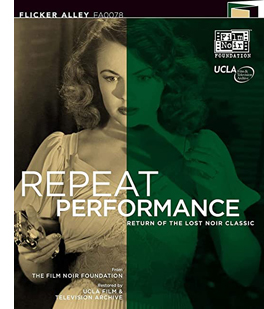 Eddie Muller’s introduction points out that a noir like Night Has a Thousand Eyes (1948) also invokes otherworldly forces. But like the Guilty adaptation, the source has been heavily altered. William O’Farrell’s novel Repeat Performance is told from the viewpoint of a man being hunted for strangling his wife. It’s a thriller more closely tied to the conventions of what we think of as noir. By switching the action to the viewpoint of the wife, and eliminating the police pursuit, the film gives us something closer to another cycle of the 1940s.
Eddie Muller’s introduction points out that a noir like Night Has a Thousand Eyes (1948) also invokes otherworldly forces. But like the Guilty adaptation, the source has been heavily altered. William O’Farrell’s novel Repeat Performance is told from the viewpoint of a man being hunted for strangling his wife. It’s a thriller more closely tied to the conventions of what we think of as noir. By switching the action to the viewpoint of the wife, and eliminating the police pursuit, the film gives us something closer to another cycle of the 1940s.
During that decade, filmmakers continued a Hollywood vein of fantasy—most obvious in the ghost films that proliferated, but also in tales of divine intervention by angels and other forces. Here Comes Mr. Jordan (1941) and It’s a Wonderful Life (1946) visualize alternative futures for their protagonists. Portrait of Jennie (1949) suggests a time stream operating alongside that of normal life, and some films with prophetic dreams suggest that the characters’ fates are determined.
Other media dabbled in the alternative-universes premise. Most famously, J. B. Priestley experimented with forking-path plots in the play Dangerous Corner (1932). (I talk about the film version here.) His later dramas, such as Time and the Conways (1937) and I Have Been Here Before (1937), pursue parallel timelines, but the closest to Repeat Performance, I think, is his remarkable “mystery” An Inspector Calls (1945).
It’s no spoiler to say that the plot of Repeat Performance restarts the time scheme of the action. On New Year’s Eve, as 1947 starts, the actress Sheila Page shoots her husband Barney. But as she leaves the murder scene, she enters the world a year earlier, on the first day of 1946. As the voice-over narration explains, she will relive that year.
After Sheila understands that she has a reprieve, she sets out to change the events that led up to her crime. She tries to keep Barney sober and focused on writing his next play, and above all she struggles to keep her rival Paula Costello away from him. She wants, she says, to “rewrite the third act.” Yet even when she changes the circumstances, accidents intervene to block her efforts. She fears that the onset of 1947 will drive her to kill again. Can she thwart destiny?
The result yields a satiric portrait of Broadway backstabbing, while cleverly suggesting that the changes in Sheila’s future are like revisions of a play in production. During a rehearsal, she suggests improving Act II by “playing it backwards”—that is, putting the scenes in reverse order. Yet they yield the same consequences, just as she will learn that her fate doesn’t care about the particular patterning as long as “the result is the same.”
Like Back to the Future (1985), the film is a time-travel adventure that aims to reset the past. It reminds us that a lot of modern movie storytelling consists of shrewd revisions and updatings of premises that had their sources in earlier Hollywood periods—particularly the 1940s. Fans of The Twilight Zone will have fun with Repeat Performance.
The Film Noir Foundation’s releases abound in no-nonsense supplements. They’re full of historical background to the films, the companies, and the personnel. On these two discs we get a detailed study of producer Jack Wrather, a rich account of the Eagle-Lion company, career summaries of Cornell Woolrich, John Reinhardt, Lee Tracy, and Joan Leslie, a pressbook for Repeat Performance, and informative liner notes. These put us in the debt to filmmaker Steven C. Smith and film historians Alan K. Rode, Eddie Muller, Imogen Sara Smith, Farran Smith Nehme, Brian Light, and many interviewees. Not only the films but the bonus materials are excellent additions to a cinephile’s collection.
The Daily Variety review of Repeat Performance is in the issue of 23 May 1947, p. 3. For my take on Cornell Woolrich and cinema, go here. I discuss Repeat Performance along with other fantasy-laden films of the period in Reinventing Hollywood: How Filmmakers Changed Movie Storytelling, chapter 9.
Repeat Performance (1947).
Welcoming Jews as heroes in an alternate 1924 Vienna
The City without Jews (1924).
Kristin here:
Once again Flicker Alley has released a restoration of a film that few have ever heard of. But we all should have heard about this one. And we should have wanted to see it. Now we can.
The City without Jews (Die Stadt ohne Juden) is an Austrian silent film released in 1924 and directed by H. K. Breslauer. It falls into the brief cycle of films about Jews released in the first half of the 1920s. I’ve written about this briefly in regard to Flicker Alley’s earlier Blu-ray of another film in this cycle, E. A. Dupont’s Das alte Gesetz (1923). The other notable Jewish-themed films are the Expressionist classic Der Golem: Wie er in der Welt kam (Paul Wegener and Carl Boese, 1920) and Carl Dreyer’s first German film, Die Gezeichneten (“The Stigmatized Ones,” called in Danish Elsker hverandre, or “Love One Another,” 1922). Thus The City without Jews is, as far as I know, the last entry in this cycle.
The Russian Revolution and civil war had driven many “Eastern Jews” into Europe, and they, created an anti-immigrant sentiment that grew into a more generalized intolerance toward the more assimilated Jews already in these countries. The earlier films had made little reference to the current growth of antisemitism in Europe and particularly in Germany and Austria. Der Golem was a period fantasy, Dreyer’s film dealt with pogroms in 1905 Russia, and Das alte Gesetz was a drama largely about conservative attitudes toward assimilation within the Jewish community.
Beslauer’s film was based on a satirical novel of the same name (1922) by Hugo Bettauer. It has proven his most famous novel, though undoubtedly in film circles he is best known as the author of Der freudlose Gasse, the source for G. W. Pabst’s 1925 classic of New Objectivity. Bettauer was a controversial figure, given the rising right-wing extremism in the mid-1920s. Perhaps spurred by the release of the film, a dental technician and member of the National Socialist Party assassinated Bettauer in early 1925; the assassin was sentenced to 18 months in a mental clinic and then walked free.
Despite an initial success in Vienna, The City without Jews was shown only a few times abroad, in various censored or abridged versions. The last known screening was in the Netherlands in 1933, as a anti-Nazi film. Portions of an incomplete print of that version, added to reels found in 2015 in a Parisian flea market, formed the basis of the current restoration. Given its sources, the result can hardly be identical to the original, but it plays very smoothly, and there are no noticeable remnants of gaps or re-editing. An account of the restoration is offered by Anna Dobringer as one of several brief essays in the booklet accompanying the dual DVD/Blu-ray release by Flicker Alley.
A satirical, serious picture of antisemitism
Of the four Jewish-themed films mentioned above, The City without Jews is the only overtly political one. Beslauer’s film, the action takes place in “Utopia,” a thinly disguised Vienna (where the film was shot), and many of the main characters are the Councillors and Chancellor.
The film starts by emphasizing that assimilated Jews already established in Utopia worship alongside the recent Eastern Jews, as suggested by the two foreground figures in the opening synagogue scene (see top). The government finds it convenient to blame various problems, such as rising prices and unemployment, as well as the fall of the country’s currency, on the Jewish population. With mounting popular unrest, the Chancellor accedes to the idea of expelling all Jews from the city.
The result is a rather uneasy balance in the early portions of the film between satirical views of the local politicians, officials, and businessmen, and the very real sufferings of the Jews and their Christian supporters and spouses. (The film is a quite polished and expensive production, as the legislative chamber, above, shows.) The Christian officials are treated as caricatures, rather similar to the way officials are portrayed in Soviet films of the second half of the 1920s–which Breslauer, of course, could not have seen.
The scenes of the entire Jewish population being expelled, on the other hand, is treated quite seriously and fairly realistically. Scenes of families being dragged out of their homes are not at all humorous, and the departure en masse by train calls to mind methods that were to be used in reality little over a decade later–though here the trains are ordinary passenger ones rather than cattle-cars.
A rather odd premise which the film emphasizes is the impact that the expulsion has on marriages between Jews and Christians. No fewer than five mixed couples of various classes are made prominent, and all are ripped apart. One involves a rabid anti-Semite, portrayed as a drunken dolt. His daughter has married a Jewish man, and they have a daughter. The scene of the husband’s departure shows the anti-Semite (in dark coat at the center below) grieving along with his daughter as they watch the little girl saying good-bye to her father.
The author and filmmakers seem to understand well the familiar phenomenon of the bigot who is only brought to sympathize when people who are discriminated against turn out to be members of their own family.
Pure satire takes over
Once the Jews are gone, the satirical approach fully takes over. It turns out that the Jews had been the foundation of everything good and strong in the Utopian society. Businesses collapse, the currency falls, foreign countries boycott Utopia, and foreign banks (being controlled by Jews) refuse to loan the failing government money. The Chancellor and his allies lament that they no longer can blame the Jews for these problems.
More amusingly, the culture falls apart. High society people who had only dressed elegantly because Jews did decide that they don’t need to buy the latest fashions. One powerful businessman who runs an expensive ladies’ clothes emporium discovers that his establishment is no longer profitable (below left). Austrian men abandon their dignified suits and revert to their casual clothes and giant tankards of beer (right). The sophistication associated with the Jews has disappeared. (All this forgets the recently arrived Eastern Jews, with the action concentrating on the very much assimilated ones.)
Among the five Jewish-Christian couples separated by the expulsion is Leo Strakosch, who is engaged to the daughter of one of the local Councillors. He emerges as the film’s protagonist, returning to Utopia in the persona of a Parisian painter and Roman Catholic. His disguise makes him look like a thinner version of Dr. Mabuse (top of this section), and one suspects that Lang’s two-part film, released in 1922, had not gone unnoticed.
Like Mabuse, Leo manipulates the dire political situation, campaigning for a repeal of the expulsion order and a return of the Jews as the only way to save Utopia’s situation. He does so, of course, in a good cause. Ultimately the decision concerning the repeal hangs on a single vote lacking for the two-thirds majority needed to rescind the order.
Leo gets one of the Councillors drunk and sends him away during the vote, thus causing the repeal to succeed.
The result is a huge success. Jews return, sales and the currency rise, mixed couples are re-united, and the government now credits the returning Jews with the restoration of the country’s health. Strakosch, now out of his disguise, is greeted as the first returnee by cheering crowds and bouquets.
Expressionism as revenge
The drunken Councillor whose lacking vote caused the return of the Jews ends up in a scene that quite explicitly imitates the end of The Cabinet of Dr. Caligari. He dreams of being imprisoned in a cell with Jewish stars built into the scenery (see bottom). He recoils in horror at the sight. This is followed by a shot of a doctor (above) who declares, “A strange case of delirium, my dear colleague. The man imagines himself to be a Zionist.” I dearly hoped that he would go on to say, “I think I know how to cure him now,” but it was not to be. Obviously the diagnosis is completely wrong, since the Councillor is terrified by the Jewish imagery in his cell. But of course, Dr. Caligari’s diagnosis may have been wrong as well.
The film is accompanied by a charming score, provided by pianist Donald Sosin and violinist Alicia Svigals. For a list of bonus materials, click on the link at the top of this post.
The City without Jews has fallen into the state of an obscure film, no doubt, but it deserves more attention now than it received at the time of its release. It has become a cliché to point out that a film of the past speaks to our current world situation. Still, this film does.
Thanks to Jeffery Massino and the team at Flicker Alley!
Two more classics from Flicker Alley
Fragment of an Empire (1928).
Kristin here:
Our friends at Flicker Alley have once again provided access to major works of silent cinema with two Blu-ray releases: Marcel L’Herbier’s L’Argent (1928) and Fridrikh Ermler’s Fragment of an Empire (1929).
Fragment of an Empire
When I was in graduate school, back in the 1970s, Ermler’s Fragment of an Empire (more accurately translated as “Remnant of an Empire”) was considered one of the major examples of Soviet Montage cinema. Its place in the canon seems to have faded since then, but this Blu-ray should restore its reputation.
Earlier prints of its were dicey. Its most famous scene was one in which the protagonist approaches a life-size crucifix at night on a battlefield and discovers that the head has been fitted with a gas-mask. David remembers seeing a print in which this image was present. I remember watching the film, expecting to see this image and being disappointed that it was not there. (I expected it because most histories of cinema that mentioned Fragment would use a production still of the crucifix.) Why the shots of the crucifix were removed is not clear, though presumably in countries where religious groups had some say in censorship matters, they were removed as blasphemous.
Peter Bagrov, formerly of the Gosfilmofond archive in Russia and now Curator of the Moving Image Department at George Eastman Museum, was centrally involved in the film’s restoration and provides the essays in the accompanying booklet. According to him, nine prints of the film from archives around the world were examined for this restoration. Only two of them contained the gas-mask Christ shots, one of them being the Museum of Modern Art’s distribution print. David probably saw that. I saw another version; I don’t recall when or where. Bagrov suggests that some prints that circulated as the “canonical” version of the film were in fact an abridged, simplified version made at the time for circulation to the uneducated rural population. Now we can all see something very close to the full original 1929 copies.
The film’s title refers to Filimonov, who is initially suffering from amnesia and working as a hired hand for a peasant woman at a remote stop on a rail line. Seeing a woman on a passing train triggers his memory, and he realizes that she is his wife and that he was a non-commissioned officer during the World War I. Going home to St. Petersburg, now Leningrad, he is shocked by the modern architecture and short skirts, as well as the fact that the owner of the textile factory where he had worked is no longer the master there. He gets a job at the same factory. Who, he repeatedly asks his fellow workers, is the master?
Fragment of an Empire falls into the common Soviet plot pattern of following a character who at first resists or ignores the revolutionary changes in the USSR but comes to understand and support them by the end. It also falls into the “Rip Van Winkle” pattern of a character who, either through amnesia or some fantastical time warp, is thrown into a society that has moved ahead without him or her. It’s a convenient way of defamiliarizing, as the Russian Formalists would say, that new society.
The opening third or so of the film is its most impressive portion. Several early segments take place at night on the bleak, flat land around the train tracks. Ermler makes impressive use of the new arc searchlights that had been developed for surveillance during the war. These intensely bright lamps made shooting in exteriors at night practical for the first time. Ermler created stark, white strips of light against pitch black, picking out individuals from a great distance (see top). The effect at times resembles some of the abstract experimental shorts of the 1920s.
In the opening scene, the bodies of soldiers who have died of typhus are heaped on a train platform to be buried. The peasant woman orders Filimonov to strip them of their boots, but while doing so he finds one wounded soldier still barely alive and saves him. The second sequence has Filimonov spotting his wife and beginning to piece together his memories. Back at home, more reminders trigger a series of quick flashbacks: a sewing-machine’s crank leads to a machine-gun firing, a rolling spool recalls wheels of trains and tanks. A somewhat more extended flashback involves a tank advancing on a soldier as he prays and begs for help from the gas-mask-outfitted crucifix before being crushed–a traumatic scene presumably witnessed by Filimonov, though he is not shown. Through much of the extended recovery Ermler employs the extremely short shots, graphic conflict, and dynamic angles (below) typical of Soviet Montage filmmaking.
Perhaps inevitably, once Filimonov has fully regained his memory and gone to Leningrad, the film becomes more conventional. For a while he wanders about, simply staring and commenting in confusion and disbelief at the modern buildings and people he sees. His hiring at the factory and misunderstanding about who is master there generates some humor as the other workers tease him–in a comradely way, of course. As they explain the new egalitarian society to him, Ermler launches the longest and most varied “work is glorious” montage sequence I have ever seen in a Soviet film of the era, with joyous workers wielding everything from saws to microscopes and, yes, movie cameras.
There is also a brief but amusing scene in which Filimonov takes his old tzarist war medal to donate it to a collection of theatrical props. The bizarre objects in this little warehouse recall the decadent ones Eisenstein uses to characterize the tsar’s quarters in the previous year’s October. This scene, along with much of the motif of Filimonov’s medal, was also eliminated from the “village” version. The intertitles restored in Russian with the original graphic layouts of the original, so that when Filimonov’s repeatedly cries “Who?” when he asks who the master of the factory is, the word changes size and position on the black background from title to title. (There are English subtitles throughout.)
One praiseworthy decision made by the restorers was to leave in the lines of the splices.
These splice-lines are of use to the historian and analyst. Watching a 35mm print on an editing machine, one can examine these directly on the filmstrip. The temptation to “clean up” the images to look pure and attractive, however, too often leads to their elimination. They are part of the original film and should always be left as is.
The Flicker Alley disc is NTSC but without region coding.
L’Argent
Marcel L’Herbier, though not one of my favorite directors, even of the silent period, was a major French director and has appeared on this blog a number of times. I included films by him in my annual list of the ten best films of ninety years ago: El Dorado for 1921 and L’Argent itself for 1928. Flicker Alley has been particularly kind to L’Herbier, and I have discussed their releases of his L’Inhumaine and Feu Mathias Pascal. Having summarized the importance and style of L’Argent in the 1928 post, I’ll concentrate here on the restorations and supplements of the existing discs.
This is the third restoration of L’Argent. The original negative and a finegrain positive made from it survive. In 1971 a restoration was done from this material, but someone made the unwise decision to step-print the new version to simulate the 16 frames-per-second shooting/projection speed of silent cinema. In fact, by the early 1920s the speed of the majority of films was up to around 20 fps, and by the late 1920s, it had reached nearly the same as sound films, around 24 fps. The resulting print of L’Argent, already quite a long film for its day, was off-putting indeed.
A 1994 restoration removed the step-printing and produced a version of excellent visual quality; it provided the basis for the “Masters of Cinema” two-disc DVD set from British company Eureka!, released in 2008. My discussion of L’Argent in the ten best of 1928 included frames from that version, which is no longer in print. It has not been released in a Blu-ray edition.
The third restoration, done by Lobster Films in 2018, forms the basis for the new Flicker Alley Blu-ray disc. (The ongoing cooperation between the two companies has made possible many of Flicker Alley’s discs of splendid copies of hitherto rare or inaccessible silent films.) The original camera negative was scanned in 4K for this new version.
Those who do not own the Eureka! set should welcome the renewed availability of this major film, perhaps L’Herbier’s finest.
Although there is some overlap between the supplements on these two releases, there are also significant differences. Both Eureka! and Flicker Alley include include a 40-minute documentary, Jean Dréville’s Autour de L’Argent (“About L’Argent,” 1928), an elaborate early “making-of” docmentary. Eureka! also offered a 54-minute 2007 documentary, Marcel L’Herbier: Poet of the silent cinema, not in the Flicker Alley release.
Flicker Alley, however, has two items not in the earlier Eureka! set. One is a five-minute short in which Serge Bromberg discusses “The Two Restorations of Auteur de L’Argent“, the Dréville documentary. More importantly, the other is a previously unavailable film, Prometheus Banker (Prométhée banquier). L’Herbier made this 16-minute short in 1921, apparently based very loosely on Zola’s novel, L’Argent. In retrospect, it looks like a brief sketch for the feature-length L’Argent, though it works as a one-reeler. It features L’Herbier’s familiar actors of the early 1920s: Eve Francis as the banker’s lover who longs to return to her happier, humbler beginnings (see below), Jacqe Catelain as the banker’s secretary, and Marcelle Pradot as the jealous typist. Apart from being an interesting early Impressionist film in itself, it provides a useful contrast in styles between similar stories told in 1921 and 1928 by the same director.
Neither the Eureka! release nor the Flicker Alley one has a commentary track. The Eureka! booklet is 78 pages long, with a lengthy essay by Richard Abel and a 1968 interview with L’Herbier, as well as some 1929 reviews of L’Argent. The Flicker Alley booklet is 23 pages, with essays by Mirielle Beaulieu.
According to the box and the film’s webpage, L’Argent is A/B/C, i.e., all regions (though the disc itself is marked A). It is presumably NTSC.
Many blog entries have discussed the Soviet Montage style; see this category. For more on French Impressionist cinema, see Scorsese, ‘pressionist and An old-fashioned, sentimental avant-garde film. We provide background on the two movements in Chapters 4 and 6 of Film History: An Introduction.
September 1, 2020: The Fragment of an Empire release has won The Peter von Bagh Award at the 2020 Il Cinema Ritrovato DVD Publishing Awards.
Prométhée banquier (1921)
Ladies at all levels
La cigarette (1919)
Kristin here:
Earlier this month Flicker Alley released another of its ambitious collections of historic films, Early Women Filmmakers: An International Anthology. The dual-format edition contains three discs DVDs and three Blu-ray discs. Its ambitions are reflected in part by the volume of material included (652 minutes) and in part by the range of its contents, from well-known classics to obscure titles.
The collection was one of the last projects curated and produced by the late David Shephard. As with many of Flicker Alley’s releases, it was a joint project with Film Preservation Associates (Blackhawk Films) and Lobster Films of Paris, working with several film archives. The films are arranged chronologically, with the earliest being Les chiens savants (1902), a music-hall dog act attributed to Alice Guy Blaché, and the latest Maya Deren’s classic experimental film, Meshes of the Afternoon (1943).
The publicity for the collection emphasizes that “More women worked in film during its first two decades than at any time since” (from the slipcase text). I would be interested in how such a claim was arrived at. It seems unlikely to me, if only because the film industries of the major producing countries have grown enormously since the silent and early sound periods. Still, despite this claim, the notes in the accompanying booklet (written by Kate Saccone, Manager of the Women Film Pioneers Project) describe how the DVD/Blu-ray release “reclaims that stature of ‘woman director’ and celebrates it in all its glory.” (One film included, Discontent [1916], is listed as “by Lois Weber”; in this case she wrote the screenplay, which was directed by Allen Siegler.) Thus the program does not survey the range of filmmaking work women performed–but such a survey would be essentially impossible. The lack of detailed credits on early films makes it difficult to determine even the director of a given film.
The silent films
It is not really possible to discuss all the films, but I’ll mention some and link to earlier entries where we’ve discussed some of them.
Of the 25 titles on the three discs, fourteen are silent. Six of these give an overview of work of Blaché, with three French films and three made after her move to the US.
Lois Weber is represented by three films, starting with perhaps her best-known work, Suspense (1913). With its unusual angles (see above), elaborate split-screen phone conversations, and action shown in the rear-view mirror of a speeding car, this is one of those films you show people to demonstrate how wonderfully inventive directors around the world became in that incredible year. I am also very fond of her feature, The Blot (1921).
The third Weber film, Discontent (1916), may surprise those familiar with her socially conscious features. In the mid-1910s Weber worked in a variety of genres. While David was doing research recently at the Library of Congress, he watched some incomplete or deteriorated Weber films that haven’t been seen widely. He wrote about False Colors here and here. Discontent is a comedy with a moral. An elderly man is living in a home for retirees, but he envies his well-to-do family. Finally they invite him to live with them, and naturally everyone ends up annoyed by the situation–including the protagonist, who winds up returning to the home and his friends.
Mabel Normand apparently directed quite a number of her films for Mack Sennett, and Mabel’s Strange Predicament (1914) is one of them. Its cast also includes Charles Chaplin and was his third film to be released, although it was the second shot and the first one in which he wore a version of his Little Tramp costume. Not surprisingly, he steals every scene he’s in. Normand even plays second fiddle to him, with her character forced for a stretch of the action to hide under a bed, where she is barely visible while Chaplin performs some funny business in the same room. (The print seems to have been assembled from two different copies, the bulk of the film being in mediocre condition with the ending abruptly switching to a much clearer image.)
One curious item in the program is Madeline Brandeis’ The Star Prince (1918). According to her page on the Women Film Pioneer’s Project, Brandeis was a wealthy woman who made films, mainly centering around children, as a hobby. Some of these were apparently intended for educational use. The Star Prince, her first film, is clearly aimed at children. A few of its adult characters are played by young adults, while children play both children and adults. This becomes a bit disconcerting when we assume for a long time that the prince and princess are perhaps seven or eight, until they fall in love and become engaged.
Despite the amateur filmmaking, there are some attempts at superimpositions and other special effects to convey the fantasy, as well as an charmingly clumsy pixillation of a squirrel puppet, the position of which is changed far too much between exposures.
This is the sort of local production, made outside the mainstream industry, that so seldom survives, and it is a welcome balance to the more sophisticated works that make up the bulk of this collection.
Speaking of which, the next part of the program consists of two features by one of the best-known female directors, Germain Dulac. The first, La cigarette, appeared in 1919. It’s melodrama about an fifty-ish Egyptologist, who has just acquired the mummy of a young princess who was unfaithful to her older husband. The professor begins to imagine that he is suffering a similar fate when his young and beautiful wife (see top) begins spending time with an athletic young fellow.
I remember seeing this film nearly forty years ago and thinking it was pretty weak. Luckily I have seen many films from this era since and know better how to watch them. Seeing it again I liked it quite a bit. It’s beautifully shot and well acted, and its sympathetic depiction of the doubting husband and the clever and resourceful wife is more subtle, in my opinion, than that of the marriage in The Smiling Madame Beudet (which is also included in this set). I was glad to have a chance to see the film again and recognize it as being among Dulac’s best work.
The silent section of the program ends with Olga Preobrazhenskaia’s The Peasant Women of Ryazan (1927). The title emphasizes that Preobrazhenskaia’s film is set in a provincial area. Ryazan, the capitol, is about 120 miles southeast of Moscow, so it is not one of the far-flung regions of the USSR. Still, it would have been distant enough at the time to have its own distinctive culture. Peasant Women gives us plenty of local costumes and customs without giving the sense of this being ethnography first and narrative second. Exotic though it may seem to us, this would have been recent history to Russians when it first came out.
Although most synopses claim that the story runs from 1916 to 1918, it actually begins shortly before World War I, probably in 1914, as the heroine Anna marries Ivan in a lively wedding scene including a carriage ride for the bridal couple (below). Shortly thereafter news of the war comes, and Ivan reluctantly departs for to serve in it. Anna is left in the household of her lecherous father-in-law, who rapes and impregnates her. The war goes on and ends, with the Revolution taking place entirely off-screen.
The second woman of the title is Wassilissa, a tougher sort, who applies to convert a decaying local mansion (we are left to assume that it was confiscated in the wake of the Revolution). She is seen at the end as being the prototype of the new Soviet woman, though Preobrazhenskaia throughout avoids hitting us over the head with overt propaganda.
The sound films
Perhaps not surprisingly, most of the directors on the third disc, devoted to sound films, are likely to be more familiar to modern viewers. Nevertheless, Marie-Louise Iribe and her film Le Roi des Aulnes (1920), were completely unknown to me. She was the niece of designer Paul Iribe and worked primarily an actress during the 1920s, and this seems to have been her only solo directorial effort. (IMDb lists her as the co-director of the 1928 version of Hara-Kiri, which she also starred in.)
Le Roi des Aulnes is one of the musically based movies that were popular in the early sound era, being based on both Goethe’s and Schubert’s versions of “Der Erlkönig.” It’s nicely photographed, and the part of the father is played by Otto Gebühr, known for being trapped by his resemblance to Friederick der Grosse into playing that role time after time from 1921 to 1941. He’s predictably excellent here, though the stretching of the short poem into a 45-minute film forces him to register worry and eventually grief throughout. Indeed, despite extrapolated incidents, such as the injury of the father’s horse and the need to procure a new one, a great deal of repetition occurs: lots of riding through marshes and menacing appearances by the Erlkönig, who is portrayed as a large man in chain-mail.
The special effects are the most impressive thing about the film, using double superimpositions in widely different scales, with the giant king holding a small fairy on his palm.
Despite its problems, the film is a valuable addition to our examples of this mildly avant-garde trend that flourished for a short time.
Most of the rest of the directors are well-known and can be mentioned more briefly.
The great animator and innovator of silhouette animation Lotte Reiniger is represented by three short films: Harlequin (1931), The Stolen Heart (1934), and Papageno (1935). I have written about Reiniger’s complex compositions, including her subtly shaded backgrounds. Of the directors represented here, she is the one who enjoyed the longest career, from 1916, when she would have been 17, to 1980, when she was 81. I discuss a BFI boxed set of some of her 1950s films here. I haven’t been able to find a complete filmography, but William Moritz estimates that she made “nearly 70 films.”
Alexandre Alexeieff and Claire Parker’s A Night on Bald Mountain is similarly familiar. Like Iribe’s Le Roi des Aulnes, it falls into the genre of illustrations of existing musical pieces, being an illustration of a piece of the same name by Modest Mussorgsky, as arranged by Nikolay Rimsky-Korsakov. It was created by manipulating hundreds of pins on a large frame called a pinboard, invented by Alexeieff, his first wife Alexandra Grinevsky-Alexeieff (whom he divorced in order to marry Parker in 1940), and Parker. The textured effect is quite unlike that of any other type of animation.
Dorothy Davenport was a prolific actress from 1910 to 1934. She is perhaps most remembered as the widow of Wallace Reid, a star who died from the effects of morphine in 1923. She directed seven films over the next decade, ending with the film in this set, The Woman Condemned (1934), mostly either uncredited or signing herself Mrs. Wallace Reid.
The Woman Condemned is a B picture, produced independently and distributed through the states’ rights system. It’s a competently done murder mystery that gains some interest by withholding a great deal of information from the audience. There are two main female characters, the victim and the accused (seen below in an interrogation scene), and we have very little idea of their motives and goals until the climax of the film. The revelations involve a twist on the same level of groan-worthiness as “and then she woke up.” But again, having a little-known B picture adds to the wide variety of films presented here.
One can hardly study early women directors and skip over the favored documentarist of the Third Reich, Leni Riefenstahl. Day of Freedom (1935) is a good choice for inclusion, occupying only 17 minutes of screen time and amply demonstrating Riefenstahl’s undeniable gift for creating gorgeous images from ominous subjects.
Experimental animator Mary Ellen Bute is represented by two contrasting abstract shorts, the lovely black-and-white ballet of shapes, Parabola (1937) and the vibrant and humorous Spook Sport (1939), the latter (below) made with the collaboration of Norman McLaren.
Dorothy Arzner, the only woman to direct mainstream Hollywood A films from the 1930s to the and 1940s, is introduced via a clip from one of her most famous films, Dance, Girl, Dance (1940). In the scene, Maureen O’Hara’s character interrupts her dance routine to tell off an audience of mostly men who are cat-calling her.
Maya Deren’s first film, Meshes of the Afternoon (1943) ends the program (see bottom). It is a happy choice, since of all the films in the program, it has undoubtedly had the greatest influence on the cinema. Much of the subsequent avant-garde cinema has turned away from music-inspired abstraction and opted for ambiguity, psychological mystery, and impossible time, space, and causality.
Valuable though this collection is, I cannot help but think that some of the directors represented have been oversold. Saccone sums them up:
Together, these 14 early women director have produced bodies of work that are inspiring, controversial, challenging, invigorating, and thought provoking. These women were technically and stylistically innovative, pushing narrative, aesthetic, and genre boundaries.
Surely not all of them meet these criteria. We would hardly expect one hundred per cent of the male directors of the same era to be “technically and stylistically innovative,” so why should we expect all of the work by fourteen varied female directors to be so? Saccone quotes Tami Williams’ book, Germaine Dulac: A Cinema of Sensations. on how the director searched “for new techniques that, in the light of official discourse of governmental and social conservatism, and the modernity of the new medium, were capable of expressing her progressive, antibourgeois, nonconformist, and feminist social vision.” Saccone sees this search in The Smiling Madame Beudet, where “Dulac utilizes cinema-specific techniques such as irises, slow motion, distortion, and superimposition, as well as associative editing, to give visibility to the inner experiences and fantasies of an unhappily married woman …”
Readers might infer that Dulac innovated these techniques. Yet they had already been established as conventions of French Impressionist cinema, notably in Abel Gance’s J’accuse (1919) and La roue (1922) and Marcel L’Herbier’s El Dorado (1921). For example, Dulac surely derived the distorted image of Beudet that conveys his wife’s disgust (below left) from a similar shot of a drunken man in El Dorado (right).
This is not to say Dulac isn’t a fine filmmaker or that she had no new ideas of her own. Only that she didn’t single-handed discover these techniques, but rather she turned the emerging repertoire of Impressionist techniques toward portraying a woman’s experience.
In some cases films that were co-directed by these women are presented as their sole efforts. Lois Weber’s Suspense was directed, as were many of her early shorts, with her husband, Phillips Smalley. Quotations from interviews with both Weber and Smalley make this clear. In 1914, Smalley said of his wife, “She is as much the director and even more the constructor of Rex pictures than I.” “Even more” because Weber often wrote the screenplays for their films and in at least some cases edited them. Weber later described how Smalley worked from her scripts: “Mr. Smalley got my idea. He painted the scenery, played the leading role and helped direct the cameraman.” Directing the cameraman is part of the job of a director.
The list of films in the booklet attributes Night on Bald Mountain entirely to Claire Parker, though on the backs of the disc cases the credit is to Claire Parker and Alexandre Alexeieff. Alexander Hackenschmied (aka Hammid) is not mentioned in the list of films, and the booklet refers to him as having a “close collaboration ” with Deren, even though he and Deren are both listed as directors on the original credits of Meshes of the Afternoon.
Still, if the collection does not make the case that all of the women represented were wildly talented and innovative, it does show the variety of ways in which women managed to work both in and out of the mainstream industry. It’s valuable collection of historical examples and should be welcomed by anyone interested in the silent and early sound eras.
It is worth noting in closing that viewers should not expect all of these films to be presented in the usual beautiful restorations we are used to from Flicker Alley. Some of these films are indeed gorgeous, including the two Mary Ellen Bute shorts, Peasant Women of Ryazan, Day of Freedom, Meshes of the Afternoon, and La cigarette (though the latter has some small stretches of severe nitrate decomposition). Other prints are quite good or at least acceptable. A few of the films simply do not survive in any but battered or faded prints, notably Discontent and The Star Prince. But we are lucky to have them at all.
The quotations from the Smalley and Weber interviews are from Shelley Stamp’s Lois Weber in Early Hollywood (University of California Press, 2015), pp. 26-27.
[May 23] Many thanks to Manfred Polak, who has drawn my attention to a higher estimate of Reiniger’s lifetime production of silhouette films. Her friend and executor, Alfred Happ, put the figure at about 80. The source is an exhibition catalog from the Stadtmuseum Tübingen, which houses Reiniger’s archived material: Lotte Reiniger, Carl Koch, Jean Renoir. Szenen einer Freundschaft. Die gemeinsamen Filme. ed. Heiner Gassen and Claudine Pachnicke (Stadtmuseum Tübingen, 1994).
Carl Koch was Reiniger’s husband and collaborator; Reiniger created an animated sequence for her supporter and friend Jean Renoir’s La Marseillaise. According to Manfred, “Alfred Happ and his wife Helga were Reiniger’s closest friends and caretakers in her last years in Dettenhausen (near Tübingen, Germany). After Reiniger’s death, Alfred Happ was the administrator of her estate. If you ever come to Tübingen, visit the Stadtmuseum (City Museum), where her estate is hosted now. A part of it is shown in a permanent exhibition.” He also provided a link to a touching account of Reiniger’s friendship with the Happs.
Meshes of the Afternoon (1943)












